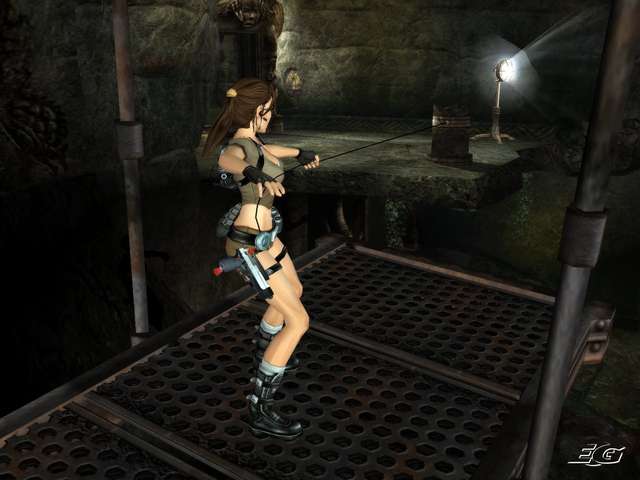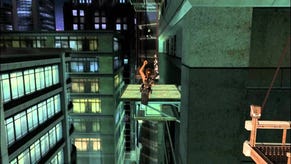Lara Croft Tomb Raider: Legend
A return to form, but only just.
Almost three years on from the Angel of Darkness debacle, Eidos knew it had a mammoth task on its hands to restore public confidence in a brand that had suffered the most humiliating critical backlash in years. Only Driv3r came anywhere near close in terms of a public mauling, and the indifferent commercial performance of Parallel Lines suggests that consumers aren't as forgiving as publishers might hope. What are the chances of Crystal Dynamics' debut Tomb Raider offering of turning the tide of ill will?
Wisely, the Californian developer has gone for the 'safety first' policy of taking the gameplay back to basics, back to the late '90s vintage when Lara's improbably proportioned torso bestrode every other magazine cover. Almost everything that made AoD a painful, hateful experience has been ditched, with much of the old-style Tomb Raider II-era globe-trotting, Tomb Raiding that so many of us loved brought back to the fore. Right from the opening section of the Bolivia level, it's immediately obvious how much homage to past glories that Legend pays, but this familiarity largely breeds warm, lasting nostalgia, rather than instant contempt.
No one should expect any kind of gameplay revolution here, though, and rightly so. Legend is full-on old-style Lara adventure, complete with its fair share of levers to pull, pressure pads to activate, traps to avoid and neuter, blocks to push and ropes to swing.
I feel stronger now

But (wait!) it's not the tired, cynical retread of the past you might expect, with the obligatory New Gadgets and Equipment(TM) increasing the interaction with the environment like never before. Chief of these is the Metallic Grappling Device, which not only plays its part in many of the puzzles, but also helps as a jump aid to help you swing across huge gaps, and a means of dragging enemies towards you in combat. To avoid the potential frustration of trial and error, all items you can grapple with have "visually distinct surfaces" (i.e. they look shinier than everything else), and once you've attached it, you can then drag it towards you, allowing you to yank pillars, boxes, switches and the like as a means of getting from A to B. Sometimes it's simply to provide a means to block the slicing blades of death from ripping your limbs asunder, other times to give you a means to avoid being roasted alive, or even to weigh something down. In many ways, Legend would be more aptly summed up as Tomb Raider Grapple, such is its reliance on this new gizmo, but it's definitely one of the better new additions. As a result, there's actually far less switch-pushing and pulling during your adventuring, and much more time spent wondering which cunning way you can use your grapple next.
Elsewhere, Lara's also been kitted out with binoculars and a Metroid Prime-style scanner, known as the Remote Analysis Device which allows you to scan the environment and find weak spots, or whether items can be moved or operated in some way - though most of the time it's pretty self-evident anyway. In addition, you also have access to a Silent Hill-esque chest-mounted torch (a - get this - Personal Light Source), which shows off the lovely dynamic lighting effects rather nicely, but - annoyingly - runs out of batteries if you leave it on for more than about a minute and then quickly recharges, begging the question, why not just let you switch it on and off? Why frustrate the player for no reason at all? Game designers, eh? Cuh.
Another item in your 'gear' is a stock of health packs (up to a maximum of three), which you can administer yourself (with a quick push of 'up' on the d-pad) when you're about to die. It's certainly a useful addition but in terms of New Things About Lara, that's about your lot. Sure, the game also tries its hand at new ideas in other areas, such as punctuating the general action at key points with some short 'cinematic' slo-mo action sequences where you have to press a specific button when prompted, but they're hilariously basic, more than a little bit pointless and not worth dwelling on, to be honest. Even less worthy are the game's two motorbike driving/shooting sections, which come across as a feeble attempt at variation, but merely serve to illustrate that Crystal Dynamics should stick to what it is best at.
Pixel imperfect

Aside from silly novelties, though, perhaps the most significant - and welcome -change to the gameplay is that Lara has been set free from the old grid-based control system, which is both a Very Good Thing, and occasionally a Not So Good Thing, as you'll discover. Old hands will notice immediately that her movements definitely feel slicker than ever. Every acrobatic somersault, every ledge shimmy and death-defying leap can now be pulled off with an assurance and a confidence that makes the game instantly feel more responsive and more enjoyable to play. The previous pixel-perfect precision that dogged some of the older games has been replaced by a system that - more often than not - reads the player's intentions. Leaps of faith to and from ropes, for example, work the way you always wanted them to, with a certain amount of invisible 'assistance' from the computer to make sure you connect. No longer does scaling crumbling rock faces and vaulting from one wobbly ledge to another require such a testing degree of "whoops, one pixel out" trial and error, with mis-timed jumps often resulting in a one-handed grasp, where players have to quickly press the Y button to steady themselves. This all makes the game feel a whole lot easier than Tomb Raider veterans might remember. It's certainly more forgiving in many respects, although there are occasions where not having a grid system means you can't just take the required number of steps back and do a run-up like before, but we can't say we missed that approach.
The combat controls certainly make things pretty straightforward for the most part, too, with a simple system that tasks the player with little more than holding down the left trigger to lock-on and fire with the right trigger. Thanks to a combination of generous controls, infinite pistol ammo and some pretty dim enemy AI, the occasions when you're heavily outnumbered pass off without incident at every stage of the game. Enemies obligingly stand around waiting to be killed (sometimes, gasp, moving behind cover), and even the ones that wield riot shields can be dispatched with a single well-placed grenade. As a nod to the past, Legend even throws in a few Leopards (and Pitbulls) throughout the game, but even they can't be bothered to put up a good fight, and the bosses - almost without exception - are unimaginative in the extreme and incredibly easy to dispatch, and only tend to hold you up via some illogical puzzle element. That said, it's just as well the combat amounts to a tiny portion of the overall gameplay - if it was a remotely important part of the experience we'd be more bothered by how utterly useless it is, but we're prepared to be slightly more forgiving than we might be because we enjoyed the main adventuring element.
A special mention has to be made about Legend's sensible checkpointing system. Often the difference between a satisfying game and a hugely frustrating one, Legend gets it right here by stopping short of the hideously forgiving quicksave method, and keeps you wanting more by never forcing the player to redo more than a few minutes of gameplay. But with several 'second chance'-type mechanics, and an unprecedented degree of hints and prompts flashing up to remind you which button to press, most experienced players will romp through the seven main levels in no more than 11-12 hours. While this undoubtedly makes the game feel somewhat shorter than previous epics, the payback is that frustration levels are kept to a minimum as a result, entertainment levels are generally high and you might actually feel compelled to see Legend all the way to the end.






